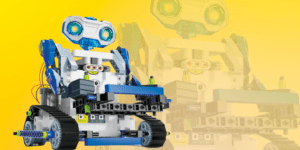Spis treści:
Robotic software – what and how?
Robots, like all electronic devices with a processor, need to be equipped with the right software to perform their functions correctly. This article deals with common programming methods and languages used in robotics.
Programmable robots around us
Robots have been around for several decades. Nowadays, they are even more technologically advanced and more easily accessible than before, when they existed only as very expensive large-scale machines for purposes such as cinematography, industry and research and development. Most robotic machines are used in factories on automated assembly lines or as auxiliary machines that assist humans in performing heavy physical work, such as in mining, forestry, agriculture and many other fields with high process complexity. There are also robots that are designed for cleaning residential buildings as well as office spaces. In terms of scope of functionality, such robots can perform vacuuming and mopping of floors along a pre-programmed route, i.e. a map of the area, in order to avoid obstacles.

Current software capabilities, make it possible to create robots that perform activities with strongly varying degrees of difficulty. Robotics programming is able to produce robots that perform relatively simple everyday tasks. Programming one’s own robot presents certain challenges, since a fully functioning robot for home or office use, in terms of mechanical design, requires six degrees of freedom to operate in the three-dimensional space of the real world in which we live. This also applies to the use of the target robot, its hardware and the program code that, through a microcontroller, will control the various actions that the robot will physically perform.
The essence of understanding robot programming
As we enter the discussion of an introduction to robot programming, it is important to bear in mind that a robot is not an intelligent machine in itself. Its performance capabilities are limited by its hardware with specific functionality, as well as by the program code by which the robot can perform the appropriate range of actions as depicted in the design.
Interestingly, a robot does not always have to mean a physical device. Robots can also exist virtually, as specialised software designed, for example, to conduct currency trading. However, returning to robots in physical form, there are autonomous robots, partially autonomous robots, and robots without autonomy. The programming of each of these robots differs from one another. For example, robots installed on assembly lines in car factories, only perform a certain range of activities automatically, i.e. without human intervention during their operation.
The target design of a robot, in terms of its degree of autonomy, the complexity of the hardware and the software layer, depends primarily on the range of activities that the robot is expected to perform, according to the design objectives. For an autonomous robot, it will probably be necessary to implement machine learning capabilities or artificial intelligence methods.
What programming languages are used in robotics?

In many cases, choosing the right programming language for our robot will depend on its target application, although this need not be a limitation. Typically, C++, Python and Java are used to program robots. These languages are popular especially among beginners in robotics, as well as hobbyists. However, when approaching robotics professionally, it is recommended to learn other programming languages that offer an even more extended range of possibilities.
This is where MATLAB comes to the rescue – an advanced environment with powerful computational and simulation capabilities that is used by engineers in almost every industry, including robotics. The process of programming the robot involves the analysis of large amounts of data using an extensive mathematical apparatus, and for this reason MATLAB is one of the best choices for an environment to create software for robots in a professional manner. On the other hand, when starting the adventure with robotics, it is worth to get acquainted first with programming in C/C++, Python and Java. When creating our first robotic project, let’s check if its programming layer will work properly in terms of functions not directly related to performing the physical activities that our robot’s design includes.
From basic prototype to advanced design
Intelligent image recognition and human voice processing with words and language-specific features are the main problems faced by designers of humanoid robots that aim to imitate the behaviour of “real” people. To enter this world, it is worth starting with an algorithm that uses a camera to recognise the faces of people entering a room. This algorithm involves mounting a motion sensor and connecting it to the camera. The motion sensor needs to be programmed so that it can trigger the activation of the camera.
A photo of a photographed person wishing to enter the room will be an element included in the input data set for the robot program. The scanned image of the face will then be compared to the real image of the person seen by the camera. The program will then compare this image with the image previously stored in memory. If the camera image is identical to the reference image, the door can be unlocked. If there is an unsuccessful match, the algorithm may attempt to scan the image again or take other predefined steps.

If we have already mastered face recognition technology, then our robot and its software can be extended with additional functionality, such as collecting clothes from invited guests. At this stage, it will be necessary to add an additional arm with a gripper and sensors, and for the software to calculate the distance at which the robot’s arm should be swung in order to pick up the outer garment and hang it on a hanger.
Robot programming – what should you know?
Robotics is one of the fastest growing fields of modern science and technology. Keeping up with the latest developments in the field of robots requires constant acquisition of knowledge often beyond the scope of knowledge of contemporary programming languages. If we want to understand and master robot programming, it is necessary to take into account the hardware and software requirements and capabilities of the robot. Fortunately, many platforms allow robotics programming for beginners. This is done by eliminating many of the difficulties associated with knowing how the hardware works, as made possible by the Arduino platform, for example. It can also be done by programming at the machine code level. In general, when starting out in robotics, it is worthwhile to learn the C/C++, Java and Python languages, as well as the MATLAB environment, which is the engine for advanced engineering calculations and simulations, including of robotic systems.
How useful was this post?
Click on a star to rate it!
Average rating 4.8 / 5. Vote count: 5
No votes so far! Be the first to rate this post.


